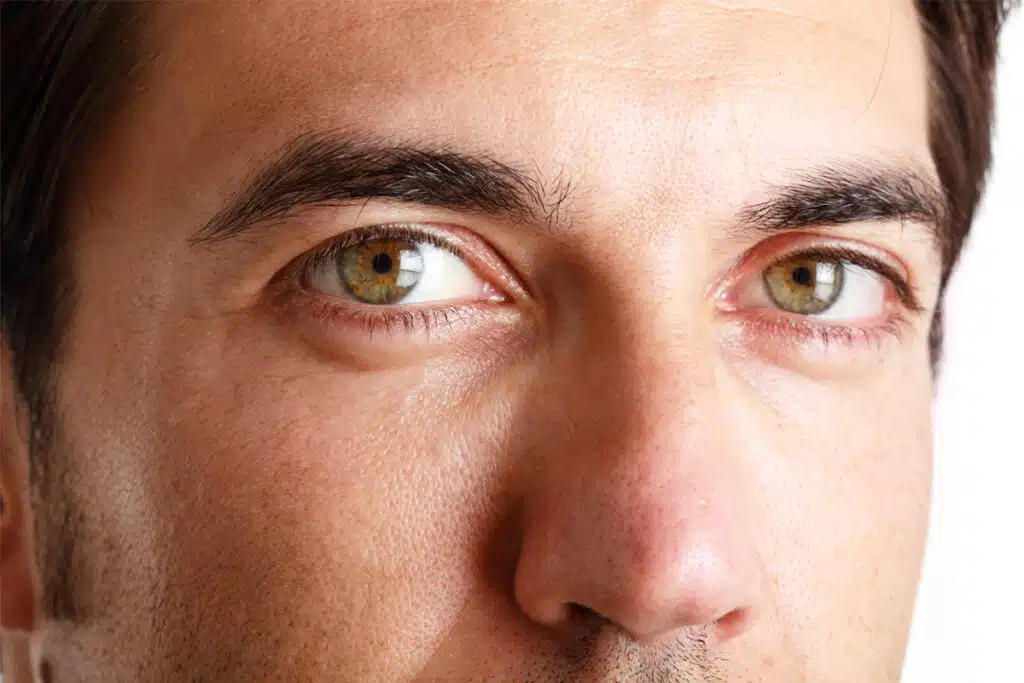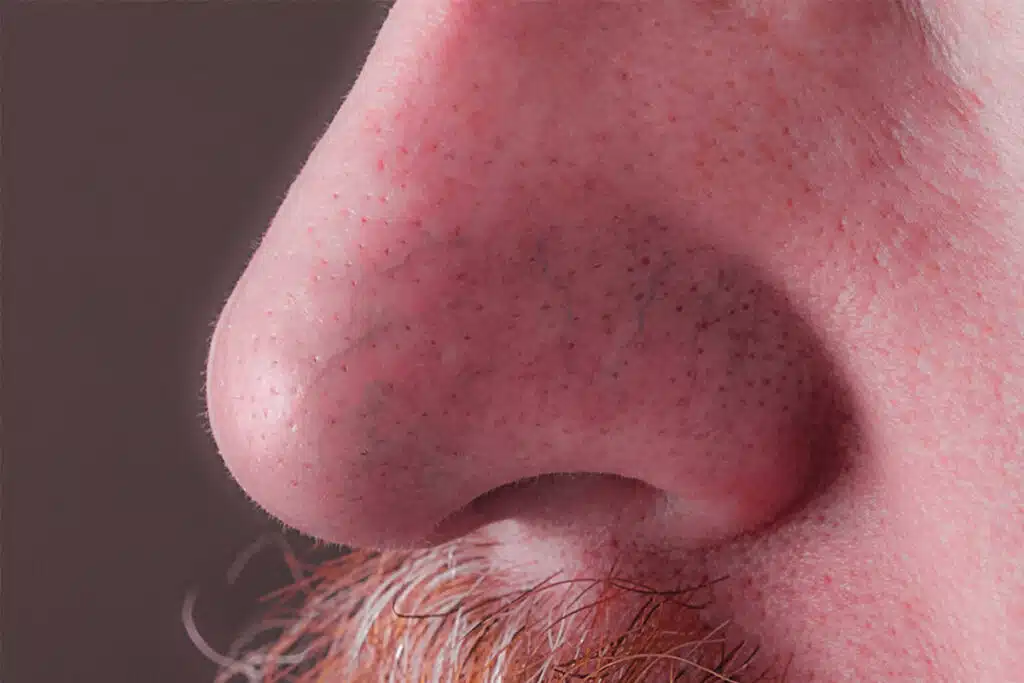Struggling with rhinophyma can be challenging, especially when it comes to deciding on the best treatment options, particularly surgery. This condition, closely linked with advanced-stage rosacea, alters the appearance and function of the nose, often taking a toll on self-esteem and quality of life. In this article, we’ll explore rhinophyma, treatment possibilities, and the road to recovery after surgery.

Rhinophyma Explained
Rhinophyma is a severe skin disorder, a subtype of a wider spectrum skin ailment known as rosacea. This condition causes skin enlargement, primarily affecting the nose. The origin of this condition can be traced to fair skin due to excessive growth and inflammation of sebaceous glands. Rhinophyma generally affects more men than women and is more prevalent in adults than children with a family history, especially Eastern European, English, or Scandinavian descent.
In some individuals, rosacea precedes rhinophyma, which exacerbates rosacea’s red, swollen, and bumpy skin texture. Severe rhinophyma is easily discernible due to its characteristic swollen and bulbous appearance of the nose. The chronic skin condition is a cosmetic concern for most due to its impact on the facial appearance but it can also cause discomfort and improper functioning of the nose.
Recognizing Severe Rhinophyma
Severe rhinophyma presents distinct signs. Key to these is excessive skin growth, primarily across the nose. This results in an enlarged, bulbous, and often red appearance. This growth, predominantly affecting the sebaceous glands, is characterized by irregular thickened skin and prominent pores.
An advanced stage of the condition can lead to distorted features and physical discomfort. As rhinophyma is an advanced stage of rosacea, people living with this condition might also experience reddish skin tone and dilated blood vessels and oil glands.
However, the intensity and skin changes associated with severe rhinophyma are more pronounced. The nose’s size and skin tone may fluctuate, causing significant embarrassment and psychological distress. In worst cases, can cause airway obstruction leading to breathing difficulties. Hence, recognizing the signs of the advanced stage is crucial for timely intervention and management of rhinophyma.
Treatment Options for Initial Stages of Rhinophyma
Exploring treatment options for rhinophyma is integral in formulating a strategy. First, oral and topical medications, part of pharmacotherapy, can reduce the progression of Rhinophyma.
Surgical options become necessary when pharmacotherapy is ineffective. These treatments can vary from dermabrasion, cryotherapy, and laser therapy to conventional surgery. Each has unique attributes in restoring the natural appearance of the nose, and the choice usually depends on the person’s condition and preference.
In all, the effectiveness of treatment options depends on the severity of rhinophyma, tolerance to the therapy, and individual preference. An experienced dermatologist will advise on the most suitable approach for each unique situation.
Understanding the Treatment for Rhinophyma
Rhinophyma surgery requires advanced techniques for effective treatment. Several methods have been proven successful in reducing the size and prominence of the nose. One of the preferred surgical techniques is Carbon dioxide laser therapy, which uses targeted light to eliminate excess tissue while minimizing bleeding. Alternatively, electro-surgery uses electrical currents to remove surplus tissue and is noted for its precision.
Another effective option is surgical treatment, which is often used when substantial tissue removal is necessary. Lastly, dermabrasion can be performed to smoothly buff away the overgrown tissue, revealing healthier, smoother skin beneath. The chosen treatment will largely depend on the development of rhinophyma as well as their overall health status.
Choosing the appropriate is crucial to the success of rhinophyma treatment New Jersey. Thus, it’s important to thoroughly discuss the options and potential risks with a trusted healthcare provider.

Managing Excess Tissue during Rhinophyma Surgery
In most cases, surgery is an outpatient procedure. During the surgical procedure, managing excess tissue can be challenging. Many surgeons use advanced techniques to skillfully excise the extra nasal soft tissue without compromising the structure of the nose. A delicate balance must be struck between removing the tissue completely and preserving enough skin to adequately cover the nose post-surgery.
Reconstructive techniques may be necessary to manage particularly extensive tissue. In such cases, temporary tissue expanders or skin grafts are inserted after the removal of excess nasal skin to compensate for the deficit.
Preparing for Rhinophyma Surgery
Before beginning a treatment plan for rhinophyma, patients need to consult with a qualified healthcare provider and undergo a physical exam to assess the severity of their condition. During this time, the doctor may also ask several questions related to the patient’s medical history and lifestyle habits. In some cases, a skin biopsy may be conducted to diagnose or rule out any underlying medical conditions. For a minority of patients, additional tests may be necessary before committing to surgery.
Patients should disclose all medications they are currently taking, as some may interfere with the surgery. For example, blood thinners could enhance bleeding during the operation. Smoking can also impede healing, so it’s recommended to quit or significantly reduce tobacco use in the weeks leading up to the operation.
Moreover, cleanliness is paramount, as it decreases the chance of infection. Therefore, patients should thoroughly cleanse their nasal area the night before surgery. They should also make arrangements for transportation post-surgery, as they will be under the effects of anesthesia or heavy sedation.
Recovery from Rhinophyma Surgery
After a rhinophyma surgery procedure, patients typically notice an improvement in both their skin condition and overall appearance. The process of recovery can vary depending on individual circumstances but often includes a manageable period of mild discomfort and necessary aftercare to ensure optimal healing.
During the recovery period, patients are advised to keep the skin clean and lightly moisturized, providing ideal conditions for the tissue to mend smoothly. This vital step of treatment can help to lessen any potential scarring and promote a more natural skin texture.
The use of skin therapy can also be beneficial. Patients can consider taking gentle therapies to improve skin elasticity and reduce facial redness, symptoms commonly associated with rosacea. Some targeted therapies can accelerate the healing of operated skin resulting in less visible scarring.
Aside from this, patients should refrain from touching the surgical area unnecessarily as this can lead to irritation or infection. Regular follow-ups with the medical team are also essential to monitor the recovery progress and to address any issues immediately.
Results after Surgery
Speaking about results, patients can expect a significant reduction in the size of the nose and a smoother skin texture, achieving a more normal appearance. The chronic swelling causing the characteristic bulky nose is effectively managed during surgery, and results are often noticeable immediately, with continued improvement over time as the skin heals and adapts to its new shape.
While the healing process after rhinophyma surgery can require time and dedication, the transformative impact on a patient’s appearance and self-esteem is often considered worth the effort.
Living with Rhinophyma Post-Surgery
Life after New Jersey rhinophyma surgery presents a much-desired relief for patients. One significant change they experience is an improved appearance, as the surgery removes the excess tissue causing the enlarged, bulbous nose characteristic of severe rosacea. Patients often report an increase in self-confidence and overall quality of life.
Surgical results are typically long-lasting, though the underlying rosacea condition may continue to affect the skin. Thus, patients must follow some guidelines to manage their condition effectively:
- Maintain a robust skincare regimen
- Avoid exposure to sunlight and cold temperatures
- Avoid spicy foods and alcohol intake
Regular check-ups are also essential, ensuring that any potential recurrence of rhinophyma is promptly addressed. With these continued care measures, patients can look forward to a life of enhanced self-esteem and disposition post-surgery
Potential Complications of Rhinophyma Surgery
As with any surgery, there are certain risks and potential complications associated with rhinophyma surgery. These can include bleeding, infection, scarring, and adverse reactions to the anesthesia or sedation used during the procedure. Patients should always discuss any concerns they have with their medical team before undergoing treatment.
Furthermore, although rare, some complications can persist even after the procedure. These can include contractures (a decrease in the mobility of facial muscles), asymmetrical results, or visible scars.
Consult with an Expert
If you are suffering from rhinophyma and its associated abnormal appearance, consulting with a facial plastic surgeon like Dr. Kam is your best option for treatment. A qualified professional like her will be able to evaluate your condition and recommend an optimal plan of care, tailored to your individual needs. With Dr. Kam’s expertise in rhinophyma surgery, she provides effective solutions for restoring the natural symmetry of your nose. Don’t hesitate any longer – consult with her today!
